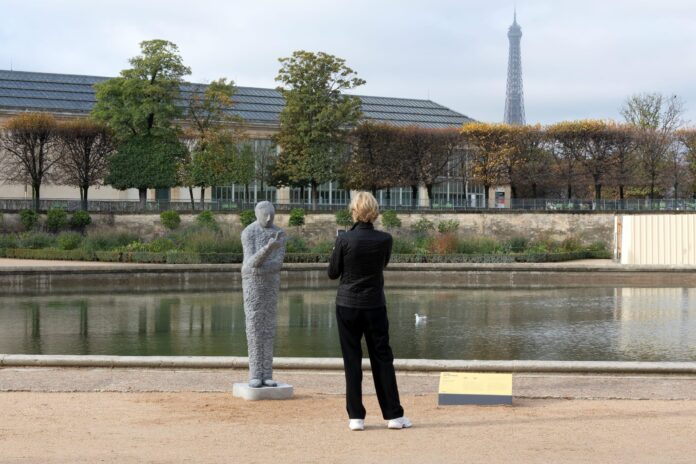As part of its public art programme Sites, Pars+ par Art Basel is taking over the Jardin des Tuileries with some ambitious site-specific projects. The exhibition La Suite de l’Histoire takes place across two sites, the Jardin des Tuileries (until 23 October) and the Musée National Eugène-Delacroix (until 24 October). The exhibition curator, Annabelle Ténèze—the director of Les Abattoirs, Musée Frac Occitanie Toulouse—has designed an open-air experience at the crossroads of history, architecture and nature. The exhibition (featuring some 20 works, all of which are for sale) resonates with the royal, political and public aspects of the gardens. Three major themes are addressed: alternative monuments, optical games and new forms of sculpture or original ways of occupying the garden. Here’s our selection of must-see works, from Carlos Cruz-Diez to Franz West.

Courtesy of the artist and Galerie Philippe Gravier
Odile Decq’s The Green Pavilion! (2022)
The first modern greenhouses were built during the Renaissance to protect plants, in particular collections of rare and exotic species. In addition to their primary function, orangeries, like the one at the Château de Versailles, were places of social interaction and a venue for festivities of all sorts. Made of steel, glass and aluminium, The Green Pavilion (June 2022) by French architect Odile Decq, evokes these functions: a table placed in the middle and bearing bread, wine and fruits and vegetables grown under glass evokes these festivities.

© Archive Franz West. © Estate Franz West. Courtesy Archiv Franz West, Estate Franz West and David Zwirner. Photo: Stephen Arnold
Franz West’s Lemurenköpfe (Lemur Heads) (1992)
The revolutionary Austrian artist Franz West set out to challenge the very ideas of beauty and ugliness. He created a rupture, reshuffled the cards and, over a 40-year-long career, redefined what was possible in the field of contemporary art. Perhaps one of the best examples are his Lemurenköpfe (Lemur Heads), which are gauze and plaster sculptures mounted on a steel base. West began this series of eyeless figures whose faces are deformed by protuberances in 1987. The first ones were exhibited in 1992 at Documenta IX, Kassel.

Courtesy of the artist and Galerie Laurent Godin
Delphine Coindet’s Cordes (2022)
For 10 years, hemp rope has been one of the favourite materials of Alberville-born artist Delphine Coindet. First used in its natural state and later covered with acrylic paint, it is employed by Coindet as a way of drawing three-dimensional abstract forms that come to life within the architectural context in which they are exhibited. In Cordes (2022), she plays with the relationship between the visual aspects of her creation and its surroundings by winding two 50-metre-long ropes around a metal swing frame, thereby establishing a dialogue between the different materials.

Courtesy Galerie GP & N Vallois, Paris and Niki Charitable Art Foundation. Photo: All rights reserved.
Niki de Saint Phalle’s Blue Obelisk with Flowers (1992)
In his Dictionary of Received Ideas, Flaubert wrote “Erection—used only in relation to monuments”. And Blue Obelisk with Flowers (1992) by Niki de Saint Phalle is indeed a monument, a stele erected to denounce phallocrats and misogynists. This militant artwork makes use of the mirror mosaic technique de Saint Phalle invented for her Tarot Garden (Giardino dei Tarocchi, 1979) in Italy; she also used it to evoke the AIDS epidemic that raged through the world in the 1990s.

Courtesy fo the artist and Galerie Cécile Fakhoury
Roméo Mivekannin’s Les Noces (2022)
Cécile Fakhoury pays tribute to the African art scene which, despite its current boom, is relatively absent from the fair. The gallery is presenting a monumental work by Roméo Mivekannin in the Tuileries, as well as a solo show on its stand. Mivekannin, who was born in the Ivory Coast and works between France and Benin, proposes a reinterpretation of his own life story and that of the Black figure, represented by self-portraits of the artist himself. In Les Noces, a life-size take on The Wedding at Cana (1562-3) by Veronese, Mivekannin explores grey areas and highlights the injustices that make up this scene that is a reflection of contemporary society.

Courtesy of the artist, Croy Nielsen and Standard
Nina Beier’s Guardians (2022)
Jointly represented by two galleries, Danish designer Nina Beier presents Guardians (2022). Four marble lions lying on the ground embody the revival, albeit ironic, of antique statuary. Stripped of their architectural and ornamental functions, the lions seem to be resting after returning to the wild. Here, Beier is reflecting on the life of monuments whose original raison d’être has disappeared, but whose former nobility remains intact allowing them, as in the Tuileries, to conquer a new space.

Courtesy of Galleria Continua
Carlos Cruz-Diez, Colonne Chromointerférente (2018)
In addition to the procession of star artists on its stand—from Gormley and Kapoor to Pistoletto—the gallery is also exhibiting a work by Carlos Cruz-Diez, whose estate it recently acquired. The eight-metre-high triangular column on show in the Tuileries is part of Cruz-Diez’s Chromointerférence series that he began in 1964. During the day, its chromatic lines produce a range of different colours that change depending on the light and its distance from the spectator. At night, a pattern of black lines moves from top to bottom and from bottom to top on each of its sides. This “unstable” creation is informed by what the artist described as the “ephemeral, ambiguous and endless” character of life.

© Galerie In Situ – fabienne leclerc
Otobong Nkanga, Anchored Glow (2017)
Nigerian visual and performance artist Otobong Nkanga lives and works between Belgium and Nigeria. She questions the notion of land, the historical structure of a place—here, the Tuileries—and the worth attributed to natural resources. With Anchored Glow (2017), Nkanga has devised an installation made up of 13 light boxes decorated with sketches and poems inserted into the ground in a topographical garden. By combining poetry and drawing, she fosters a thoughtful and contemplative mood that enchants the visitor.

























